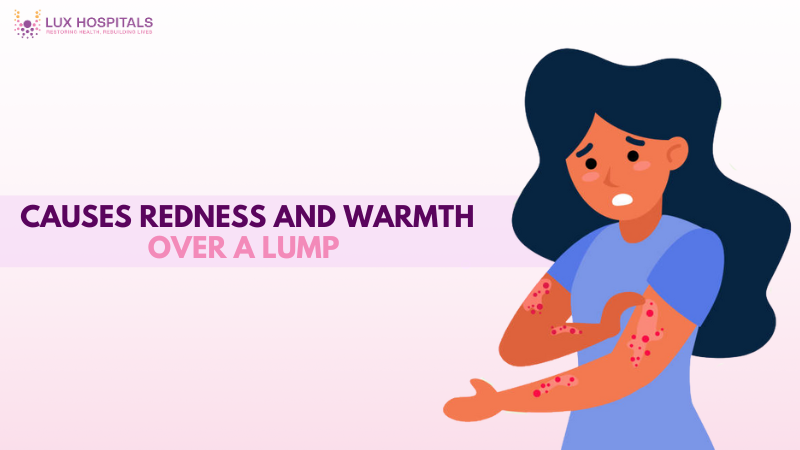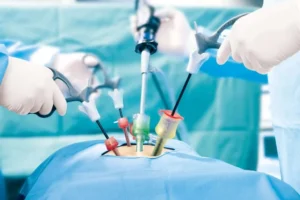What Leads to Redness and Warmth over a Lump?

Bulges on the body can be alarming, particularly if they are accompanied by warmth and redness. These extra symptoms frequently point to an underlying illness that needs to be treated by a doctor. Regardless of whether the illness is caused by inflammation, infection, or something more serious, being aware of the possible causes of warm, red lumps can help with timely diagnosis and treatment. This comprehensive review looks at the various diseases associated with these symptoms.
Common Causes of Redness and Warmth Over a Lump
Redness and warmth over a lump usually indicate the presence of inflammation or infection. These symptoms can arise from conditions such as cysts, abscesses, cellulitis, or even trauma to the area. While some causes are mild and resolve with basic care, others may require antibiotics or medical procedures.
1. Infected Cysts
An infected cyst is one of the most common causes of a red, warm lump. Cysts are sacs filled with fluid, pus, or other materials that may form under the skin. When bacteria enter the cyst, it becomes infected and causes redness, swelling, and tenderness. Infected cysts can proliferate and may require antibiotics or drainage.
2. Abscess Formation
Abscesses are collections of pus that develop due to bacterial infection, usually under the skin. They appear as swollen, red lumps that are warm to the touch and often painful. The skin over an abscess may break open and drain or need to be incised by a healthcare provider. Timely intervention stops the virus from spreading to surrounding tissue.
3. Cellulitis
Although it usually affects the lower legs, it can cause warmth and swelling, often surrounding a lump or break in the skin. Although it can happen anywhere on the body, it usually affects the lower legs. To avoid consequences, such as bloodstream infections, this sickness requires immediate medical attention. Antibiotics are usually used to treat cellulitis.
4. Inflammatory Reactions
Sometimes, the body reacts to irritants or injuries with inflammation, leading to redness and warmth over a lump. These lumps may form as a result of allergic responses, trauma, or insect bites. Even while persistent inflammation is typically innocuous, it should be examined to rule out underlying problems. Medication with anti-inflammatory properties can lessen the symptoms.
5. Boils (Furuncles)
Boils are painful lumps filled with pus caused by infected hair follicles. The area becomes red, swollen, and increasingly warm as the infection deepens. Boils may burst and drain naturally or require lancing by a physician. Good hygiene and warm compresses can help the healing process.
6. Lymph Node Swelling
Enlarged lymph nodes often present as lumps under the jaw, armpits, or groin and may become red and warm if infected. The body’s immunological response to inflammation or infection causes these nodes to enlarge. Bacterial and viral infections are frequent causes. If the swelling continues or gets worse, a medical assessment is required.
7. Soft Tissue Injuries
Bruising or trauma to muscles and tissues can lead to painful, red lumps. These hematomas develop when blood pools under the skin due to injury. The area may feel hot as inflammation sets in during healing. Rest, ice, and elevation help reduce discomfort and swelling.
8. Bug Bites or Stings
Insect bites or stings may cause red, swollen lumps that feel warm. The body’s reaction to the venom or bite causes localized inflammation. The reaction is usually mild, but some people may develop infections or allergic responses. Antihistamines and cold packs are often used to manage symptoms.
9. Cancerous Lumps
Though less common, some cancerous lumps can become red and warm due to inflammation or secondary infection. Cancers, including breast cancer and lymphoma, can cause nodules that change over time. A healthcare provider should evaluate color changes for any lump that grows or becomes tender. Biopsies are often needed for diagnosis.
10. Autoimmune Conditions
Autoimmune illnesses include lupus and rheumatoid arthritis, which can cause inflamed nodules or lumps with warmth and redness. These are often the result of immune system attacks on healthy tissues. The lumps may appear near joints or under the skin and fluctuate in size. Long-term management usually involves immunosuppressive medications.
When to See a Doctor?
Redness and warmth over a lump can indicate infection, inflammation, or something more serious. You should seek medical help if:
- The lump is painful, growing, or draining pus
- You have a fever or feel unwell
- The lump persists for more than a week
- There is rapid spreading redness
Early diagnosis ensures timely treatment and prevents complications.
Conclusion
Redness and warmth over a lump can arise from various causes, ranging from mild infections and inflammatory responses to more serious conditions like cancer. Recognizing accompanying symptoms and changes in the lump can guide when to seek medical advice. Timely intervention helps avoid complications and supports quicker recovery. Always get advice from a medical professional if you’re unclear about the nature of any lumps that change in appearance, size, or sensation.
Frequently Asked Questions
A red and hot lump indicates inflammation or infection, such as an abscess or infected cyst. These symptoms signal increased blood flow and immune response in the area. Getting medical help right away helps stop an infection from spreading.
Some cancerous lumps may feel warm, especially if inflamed or infected. However, most cancerous lumps are not painful or warm initially. It's crucial to monitor for size, shape, or texture changes.
A lump may be serious if it's hard, immobile, grows rapidly, or is accompanied by other symptoms like weight loss or fever. Redness, warmth, and pain suggest inflammation or infection, but persistent or unusual lumps require a doctor's evaluation. Diagnostic tools like ultrasounds or biopsies are often used.
Painful lumps are often caused by infections, inflammation, or trauma. They may not be dangerous, but they do require treatment. If the pain increases or the lump becomes red and warm, consult a healthcare provider. Early treatment can help avoid complications.
Cysts are fluid-filled lumps, usually benign, while tumors are solid masses that can be benign or cancerous. Cysts often move under the skin and may become red and warm if infected. Tumors usually require imaging and sometimes biopsy for diagnosis.




















